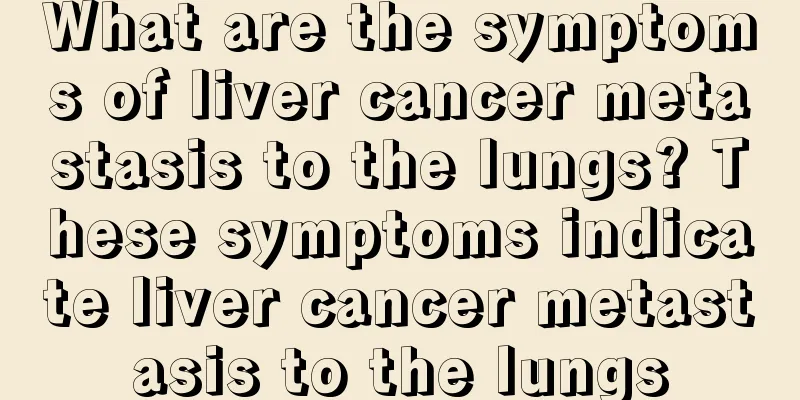What are the symptoms of lung cancer? These symptoms suggest the occurrence of lung cancer

|
Lung cancer is a malignant tumor with a very high incidence rate. Most patients have a long history of smoking. The early symptoms of lung cancer are not very obvious and can be easily mistaken for throat discomfort, delaying treatment. When the symptoms are severe, treatment becomes more difficult. What are the diagnostic methods for lung cancer? Listen to the expert's introduction below: Lung cancer is an abnormality that is often evaluated after a chest X-ray. It helps to know if the abnormality may be benign (noncancerous) or malignant (cancerous.) If the abnormality is malignant, further studies are done to see if the cancer has spread (metastasized) to other parts of the body. The most common symptom of early lung cancer is an irritating cough caused by the growth of the tumor under the bronchial mucosa, which is mostly dry cough or with a small amount of white foamy sputum. Another common early respiratory symptom is bloody sputum, usually with blood spots and blood streaks in the sputum, and occasionally intermittent small amounts of hemoptysis; large amounts of hemoptysis are only seen in a few cases of bronchial adenoma. When the tumor grows and causes varying degrees of obstruction of larger bronchi, symptoms such as chest tightness, wheezing, and shortness of breath may occur. In cases of bronchial obstruction complicated by lung inflammation or necrosis of the central part of a huge tumor to form a cancerous cavity, there are symptoms such as fever, increased sputum volume, and mucopurulent sputum. Mild chest pain is also quite common in early lung cancer cases, most of which are irregular dull pains caused by inflammation of the parietal pleura and chest wall. Early detection of lung cancer symptoms is more conducive to treatment. However, about 5% to 10% of early lung cancer patients do not have any symptoms. When they go to the hospital for diagnosis and examination, it is already in the late stage. Early detection is crucial to avoid the corresponding signs that may appear after the cancer grows and causes bronchial obstruction, and also try to avoid the invasion of cancer into the extrapulmonary tissues of the chest, and the appearance of pleural effusion, pericardial effusion, diaphragm elevation, chest wall tenderness, superior vena cava compression, vocal cord paralysis and other signs. When the symptoms of distant metastasis outside the chest can involve various parts of the body, it is already in the middle and late stages. Advanced lung cancer usually refers to the disease progressing to the fourth stage, which means that the cancer from the lungs has spread to other parts of the body, making the prognosis not so good. At this time, lung cancer patients often cough up mucus or blood or both. Dyspnea is another common symptom of advanced patients. Every time you breathe, you will have a dull pain in the chest. This pain may also extend to other parts of the body, depending on where the cancer cells have spread. Patients with advanced lung cancer usually have no appetite, which leads to weight loss, and the whole person becomes thinner day by day. |
<<: Which foods can prevent liver cancer? Check out the various foods that can prevent liver cancer
Recommend
Cooking porridge in a rice cooker
How about cooking porridge in a rice cooker? This...
What are some good ways to remove acne marks and acne pits
When adolescence, which marks the second stage of...
Will the IUD fall off
The IUD is a contraceptive tool placed in the fem...
What are the common causes of hypokalemia
Hypokalemia has a great impact on the patient'...
Nursing issues for left breast cancer
There are many treatments for breast cancer. Surg...
How to remove lipstick from white clothes?
Nowadays, women are very fond of beauty and usual...
What are some good ways to prevent liver cancer? Five liver cancer prevention measures to keep in mind
Five preventive measures According to a large num...
Daily care precautions for melanoma
In recent years, we can find that in our lives, m...
What are the common types of bile duct cancer
The incidence of bile duct cancer is not very hig...
Is intestinal tuberculosis contagious? In what way?
Intestinal tuberculosis is a common tuberculosis ...
The difference between Bayu and pufferfish
Bayu and pufferfish are two completely different ...
What to do about lymph follicular hyperplasia?
Usually when we talk about lymph hyperplasia, we ...
How do you get lung cancer? The main causes of lung cancer are as follows
Lung cancer is a common disease now, so we must p...
Does purpura itch? Symptoms of purpura
Purpura is not unfamiliar to many people. It is a...
What's going on with the blockage from the neck to the chest?
Many people in life have experienced or are exper...









